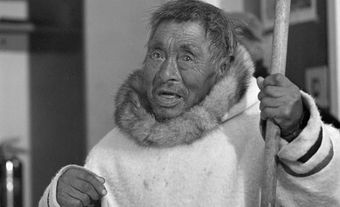
The Inuinnait, also known as the Copper Inuit because of their extensive use of artifacts made from the native copper deposits of the region, originally occupied Banks and Victoria islands and the adjacent mainland region of the central Canadian Arctic. In the early 20th century, they numbered about 800 people, divided into numerous regional bands averaging about 50. Several bands would combine during the winter when engaged in hunting seals. At this season they lived in large snow-house communities on the sea ice, moving to new areas as the local seal population was hunted out. In the spring these communities broke up and the bands moved to specific areas on the coasts, from where they travelled into the interior in search of caribou, muskoxen and fish. Throughout the summer they moved about the interior within defined territories, in small groups of one or a few families, living in skin tents. Caribou hunting was intensified in late summer, and people began to gather at points along the coast where the women prepared winter clothing.
Social organization was based on kinship and on various types of formal partnership, and affiliation between individuals tended to be more a matter of personal choice than is usually found among other Inuit groups. Religion was based on shamanism, with the shaman charged primarily with curing the sick and providing good hunting. Religion, language and most other aspects of the culture were similar to those of other central arctic Inuit groups, of whom the Inuinnait were the most westerly.
Archaeology indicates that the Inuinnait are descended from a group of Thule Culture people who moved into the area shortly after 1000 AD and adapted their maritime way of life to seal and caribou resources. During the cooler climate of the Little Ice Age of the 17th to 19th centuries, these people abandoned the permanent winter houses and other elements of their Thule ancestors. Traditionally, hunting weapons including arrows, harpoon and spear heads, and tools such as knife blades and chisels were formed from copper and used for personal use and for trade with other nations. Greater nomadism and increasing exposure and involvement with imported European technology gave rise to the distinctive culture of the historic Inuinnait. Regular European contact began during the early 20th century, involving the Inuinnait in a trapping economy. However, in addition to trade, the European contact brought diseases including influenza, typhoid and smallpox epidemics that devastated the Inuinnait population.
Most Inuinnait now live in the villages of Sachs Harbour, Ulukhaktok (also known as Uluqsaqtuua), which means "where there is copper" in Inuktitut; Kugluktuk; Bathurst Inlet; and Cambridge Bay. In 1984 the communities of Sachs Harbour and Holman [Ulukhaktok] were included in the Inuvialuit Land Claims Agreement. Other settlements were negotiated as part of the creation of Nunavut.
See also Aboriginal People: Arctic.

 Share on Facebook
Share on Facebook Share on X
Share on X Share by Email
Share by Email Share on Google Classroom
Share on Google Classroom





